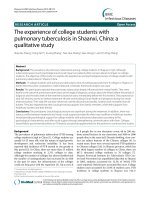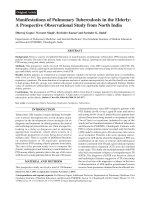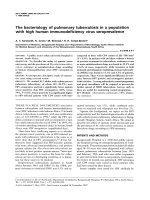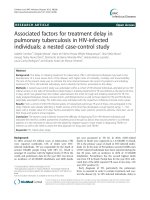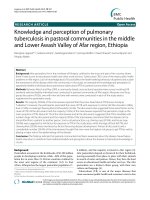Coexisting Bronchogenic Carcinoma and Pulmonary Tuberculosis in the Same Lobe: Radiologic Findings and Clinical Significance doc
Bạn đang xem bản rút gọn của tài liệu. Xem và tải ngay bản đầy đủ của tài liệu tại đây (559.43 KB, 7 trang )
138
Korean J Radiol 2(3), September 2001
Coexisting Bronchogenic Carcinoma and
Pulmonary Tuberculosis in the Same Lobe:
Radiologic Findings and Clinical Significance
Objective: Bronchogenic carcinoma can mimic or be masked by pulmonary
tuberculosis (TB), and the aim of this study was to describe the radiologic findings
and clinical significance of bronchogenic carcinoma and pulmonary TB which
coexist in the same lobe.
Materials and Methods: The findings of 51 patients (48 males and three
females, aged 48-79 years) in whom pulmonary TB and bronchogenic carcinoma
coexisted in the same lobe were analyzed. The morphologic characteristics of a
tumor, such as its diameter and margin, the presence of calcification or cavitation,
and mediastinal lymphadenopathy, as seen at CT, were retrospectively
assessed, and the clinical stage of the lung cancer was also determined. Using
the serial chest radiographs available for 21 patients, the possible causes of
delay in the diagnosis of lung cancer were analyzed.
Results: Lung cancers with coexisting pulmonary TB were located predomi-
nantly in the upper lobes (82.4%). The mean diameter of the mass was 5.3 cm,
and most tumors (n=42, 82.4%) had a lobulated border. Calcification within the
tumor was seen in 20 patients (39.2%), and cavitation in five (9.8%). Forty-two
(82.4%) had mediastinal lymphadenopathy, and more than half the tumors
(60.8%) were at an advanced stage [IIIB (n=11) or IV (n=20)]. The average delay
in diagnosing lung cancer was 11.7 (range, 1-24) months, and the causes of this
were failure to observe new nodules masked by coexisting stable TB lesions
(n=8), misinterpretation of new lesions as aggravation of TB (n=5), misinterpreta-
tion of lung cancer as tuberculoma at initial radiography (n=4), masking of the
nodule by an active TB lesion (n=3), and subtleness of the lesion (n=1).
Conclusion: Most cancers concurrent with TB are large, lobulated masses
with mediastinal lymphadenopathy, indicating that the morphologic characteris-
tics of lung cancer with coexisting pulmonary TB are similar to those of lung can-
cer without TB. The diagnosis of lung cancer is delayed mainly because of mask-
ing by a tuberculous lesion, and this suggests that in patients in whom a predomi-
nant or growing nodule is present and who show little improvement of symptoms
despite antituberculous or other medical therapy, coexisting cancer should be
suspected.
everal reports have shown that the incidence of lung cancer is greater in
patients with pulmonary tuberculosis (TB) than in the general population
(1 3). Although the incidence of bronchogenic carcinoma in patients with
active pulmonary TB has been reported as 5 6.4 % (1, 4), these data are outdated, and
to our knowledge, no report published during the era of CT has focused on this topic.
Because the signs, symptoms, and radiologic findings can be masked by preexisting
disease, a diagnosis of bronchogenic carcinoma superimposed on pulmonary TB is dif-
Young Il Kim, MD
1
Jin Mo Goo, MD
1
Hyae Young Kim, MD
2
Jae Woo Song, MD
3
Jung-Gi Im, MD
1
Index terms:
Lung neoplasms
Lung neoplasms, CT
Tuberculosis, pulmonary
Korean J Radiol 2001;2:138-144
Received February 17, 2001; accepted
after revision June 14, 2001.
Department of
1
Radiology, Seoul National
University College of Medicine and the
Institute of Radiation Medicine, SNUMRC;
Department of
2
Radiology, Ilsan National
Cancer Center; Department of
3
Radiology,
Seoul Municipal Boramae Hospital
Address reprint requests to:
Jin Mo Goo, MD, Department of Radi-
ology, Seoul National University Hospital,
28 Yongon-dong, Chongno-gu, Seoul
110-744, Korea.
Telephone: (822) 760-2584
Fax: (822) 743-6385
e-mail:
S
ficult (5). In most cases, the diagnosis of tumors in such pa-
tients is delayed, probably until an advanced stage. It has
been reported that in patients with TB, the average delay
in the diagnosis of lung cancer is 6 9 months (6), though in
this patient group, the early detection of cancer is clearly
important. The aim of this study is to describe the radiolog-
ic findings of coexisting bronchogenic carcinoma and pul-
monary TB in the same lobe. We also discuss the causes of
delayed diagnosis of lung cancer in patients with pul-
monary TB, as revealed by chest radiography, and the di-
agnostic clues which facilitate the detection of such lesions
at CT.
MATERIALS AND METHODS
Between January 1993 and May 1999, 335 patients with
coexisting bronchogenic carcinoma and pulmonary TB
were selected on the basis of the ACR (American College
of Radiology) code and the computerized disease coding
system in use at our institution. Among the 335 cases, CT
scans were available in 219. After review of the related
medical records and radiologic reports, we enrolled pa-
tients who had both histologic proof of lung cancer and co-
existing TB in the same lobe as the cancer.
There were 51 such patients (48 males and three fe-
males), and their age ranged from 48 to 79 (mean, 64.5)
years. The presence and localization of pulmonary TB was
determined on the basis of CT findings; three radiologists
reached a consensus regarding the location and activity of
tuberculous lesions. Lesions which were calcified granulo-
mas or demonstrated fibrotic change were regarded as in-
active, while those which were cavitary or consolidated,
and showed typical bronchogenic spread, were considered
active. Acid-fast bacilli in sputum were demonstrated in
ten patients, while 35 had a history of antituberculous
chemotherapy. The mean duration of TB prior to the diag-
nosis of lung cancer was 16.8 (range, 3 40) years.
Bronchogenic carcinomas were pathologically confirmed
by percutaneous needle biopsy (n=21), bronchoscopic
biopsy (n=16), sputum cytology (n=4), open lung biopsy
(n=1), or biopsy of metastatic lesions (supraclavicular
lymph node, n=6; pleura, n=1; adrenal gland, n=1; je-
junum, n=1). Histological types were squamous cell carci-
noma (n=32), adenocarcinoma (n=15), and small cell lung
cancer (n=4). Forty-six patients (90.2 %) were smokers,
and the mean pack-year figure was 42.7 (more than 40
pack-year, n=23; between 40 and 20 pack-year, n=21; less
than 20 pack-year, n=2).
All images were reviewed by three radiologists, decisions
being reached by consensus. The location of the tumor, its
diameter and margin, the presence of calcification and cav-
itation, and of mediastinal lymphadenopathy, were as-
sessed retrospectively on CT scans and the stage of the
cancer was also determined. If the short diameter of a
lymph node was greater than 1 cm, this was taken to indi-
cate metastatic lymphadenopathy.
Twenty-one of the 51 patients underwent serial chest ra-
diography prior to the diagnosis of lung cancer, and the du-
ration and possible causes of diagnostic delay were investi-
gated. When chest radiography or CT in the 21 patients
suggested lung cancer, the three radiologists retrospective-
ly reviewed previous serial chest radiographs. If they de-
termined by consensus that a lesion had been missed at
earlier chest radiography, prior to the diagnosis of lung
cancer, the duration of the delay was calculated. The caus-
es of this were categorized as failure to observe new nod-
ules masked by coexisting stable TB lesions, the misinter-
pretation of new lesions as aggravation of TB, the misinter-
pretation of lung cancer as tuberculoma at initial radiogra-
phy, masking of the nodule by an active TB lesion, or sub-
tleness of the lesion.
In patients who underwent curative surgery, the patho-
logic findings were reviewed to determine whether scar
cancer was present. This was defined as a tumor which
according to the histologic and clinical evidence arose
from a previously documented tuberculous lesion. The fol-
lowing criteria were required for a diagnosis of scar cancer:
macroscopic evidence of scarring, a central nidus of fibrous
tissue suggestive of an old tuberculous granuloma, and an-
thracotic pigmentation (7).
RESULTS
The location of tuberculous lesions was as follows: both
upper lobes (n=36), the right upper lobe (n=8), the left up-
per lobe (n=3), the right lower lobe (n=1), both upper
lobes and the left lower lobe (n=1), the right lung (n=1), all
lobes (n=1). Thus, the predominant location was the upper
lobes (n=42, 82.4%), followed by the lower lobes (n=6,
11.7%), and the right middle lobe (n=3, 5.9%). The mean
diameter was 5.3 (1.5 12) cm, and the tumor margin was
lobulated (n=43, 84.3%) or spiculated (n=7, 13.7%). In
one case of adenocarcinoma with bronchioloalveolar carci-
noma, the form of the tumor was consolidative.
Calcification within the tumor was seen in 20 patients
(39.2%), and was located eccentrically in 15 cases and cen-
trally in five. Cavitation within the tumor was observed in
five patients (9.8%), and mediastinal lymphadenopathy in
42 (82.4%). The stage of non-small-cell lung cancer was I
in ten patients, II in two, IIIA in four, IIIB in 11, and IV in
20. At the time of diagnosis, all small-cell lung cancers
(n=4) were extended.
Coexisting Bronchogenic Carcinoma and Pulmonary Tuberculosis in the Same Lobe
Korean J Radiol 2(3), September 2001
139
Serial chest radiography showed that in 21 patients, the
average delay in diagnosing lung cancer was 11.7 (range,
1-24) months and the causes of this were failure to observe
new nodules masked by coexisting stable TB lesions (n=8)
(Fig.1), misinterpretation of new lesions as aggravation of
TB (n=5) (Fig. 2), misinterpretation of lung cancer as tuber-
culoma at initial radiography (n=4) (Fig. 3), masking of the
nodule by an active TB lesion (n=3) (Fig. 4), and subtleness
of the lesion (n=1).
Mainly because of poor pulmonary function and the ad-
vanced stage of the tumor, only ten patients (19.6%) un-
derwent curative surgery. Of these, five (50%) had scar
cancer, the histological types of which were adenocarcino-
ma in three cases, and squamous cell carcinoma in two
(Figs. 1 and 2). Three patients had old tuberculous granulo-
mas and lung cancers in the same lobe, but pathologic ex-
amination showed that the lesions were completely sepa-
rated. In the remaining two patients, lung cancer and ac-
tive TB were concurrent, and some portion of the cancer
was in close contact with the TB lesions. However, because
macroscopic evidence of scarring or anthracotic pigmenta-
tion was not detected pathologically, the criteria for scar
cancer were not met.
Kim et al.
140
Korean J Radiol 2(3), September 2001
AB
Fig. 1. 60-year-old male with a two-year history of pulmonary TB.
A. Chest radiograph shows ill-defined patchy opacity (arrow) at the right apex. Because acid-fast bacilli were present in sputum, anti-tu-
berculous medication was administered. Staining for acid-fast bacilli then proved negative.
B. Chest radiograph obtained two years after A demonstrates increased opacity (arrow), which was disregarded by both the radiologist
and the patient’s clinician.
C. Follow-up CT scan obtained 10 months after B shows a 3.5 cm-sized mass (arrow) at the right apex.
D. Photograph of a cut section of the resected specimen shows a hard yellowish mass which proved to be squamous cell carcinoma.
Dark pigmentations (arrows) within the tumor were composed of tuberculous granulomas.
CD
DISCUSSION
The coexistence of pulmonary TB and bronchogenic car-
cinoma was first reported by Bayle in 1810 (8). The simul-
taneous development of unsuspected primary cancer in
close vicinity to an active pulmonary tuberculous process
can seriously complicate diagnosis, and in most reported
cases, a long interval had elapsed before carcinoma was
suspected (6). Patients with TB or post-tuberculous pul-
monary lesions require more intense attention than those
with oncological diseases alone, and the diagnosis of TB in
patients with bronchogenic carcinoma requires pathologi-
cal confirmation based on the findings of biopsy or micro-
Coexisting Bronchogenic Carcinoma and Pulmonary Tuberculosis in the Same Lobe
Korean J Radiol 2(3), September 2001
141
AB C
Fig. 2. 64-year-old male who presented with sputum.
A. Initial chest radiograph reveals the presence of a large lobulated mass (arrow), proven by percutaneous needle biopsy to be an active
tuberculous lesion, in the right lower lung zone.
B. The patient received anti-tuberculous medication, and a follow-up plain radiograph obtained six months after the initial study showed
that the lesion (arrow) was very much smaller.
C, D. Follow-up chest radiograph (C) and CT scan (D) obtained seven months after B show an enlarged mass (arrows) in spite of anti-tu-
berculous medication.
E. Photograph of a cut section of the resected specimen shows a dumbbell-shaped mass in the right lower lobe. Histopathologic exami-
nation showed that squamous cell carcinoma surrounded the scar tissue (arrow).
(From Lee KS, Im JG, Kang DS. Notes from the 1999 annual meeting of the Korean Society of Thoracic Radiology.
J Thorac Imaging
2000; 15:30-35, with permission.)
DE
biologic studies. When lung cancer has developed insidi-
ously in a known case of pulmonary TB, the diagnosis of
dual disease is more difficult than when a diagnosed case
of bronchogenic carcinoma is complicated by the presence
in sputum of acid-fast bacilli. The time required for the di-
agnosis of cancer with inactive TB is somewhat shorter
when the disease processes are located in different areas.
When cancer is associated with active TB, however, and
the two conditions coexist in the same lobe, the time re-
quired for the diagnosis of cancer is often considerable.
Outstanding progress in imaging techniques has, though,
led to increasing accuracy in the diagnosis of lung cancer.
In addition, patients in whom active TB is suspected re-
quire more attention, and are more likely to be evaluated
with CT or HRCT than those with inactive TB.
The relationship between pulmonary TB and bron-
chogenic carcinoma has been viewed in the following
ways: (A) As one of cause and effect (scar cancer). Many
researchers believe that scar tissue plays an important
causative role in the development of lung cancer (9, 10);
(B) As the reactivation of TB by carcinoma. It has also
been reported that the development of lung cancer in areas
of inactive TB stimulates the reactivation of tubercle bacilli
(5, 11). In addition, the association between bronchogenic
carcinoma and pulmonary TB may be related to increased
susceptibility to opportunistic infections, which can lead to
the reactivation of TB in cancer patients (12); (C) As coin-
cidental. Because both pulmonary TB and bronchogenic
carcinoma are common in Korean communities, they
sometimes co-occur by chance. In our study, lung cancer
(proven to be scar cancer) was present in the area of a tu-
berculotic scar in five of the ten patients who underwent
curative surgery. The central focus of lamellated hyaline fi-
brous tissue in our cases was entirely consistent with old
TB. The role of scarring in the pathogenesis of lung cancer
is, however, controversial. It was originally postulated that
a proportion of such tumors arise at the edge of pre-exist-
ing scars, and that parenchymal scarring can stimulate
Kim et al.
142
Korean J Radiol 2(3), September 2001
AB
Fig. 3. 69-year-old male who presented with cough and dyspnea,
and had been treated with antituberculous medication at the age of
39.
A. Chest radiograph shows reticulonodular opacities in both upper
lung zones, suggestive of TB. A large lobulated mass (arrow) in the
right upper lobe was regarded as tuberculous granuloma rather than
lung cancer.
B, C. Antituberculous medication offered no improvement, however,
and the CT scan obtained ten months after A reveals a 3.0-cm sized,
irregularly marginated mass (arrows) at the right apex. Sputum cytol-
ogy showed that an adenocarcinoma was present.
C
atypical epithelial cell proliferation and metaplasia involv-
ing the terminal air-space (13). Others, though, are of the
opinion that the scar represents a desmoplastic reaction
and is the result, rather than the cause, of tumor growth
(14).
Previous studies have suggested that the earliest sign of
the coeistence of bronchogenic carcinoma and TB is an
atypical course of the latter, as seen on chest radiographs.
(15). They insisted that the sudden appearance of new le-
sions, segmental or lobar atelectasis, unilateral hilar en-
largement, thick-walled cavities, and a localized pneumon-
ic process are all suggestive of carcinoma. Ting et al. (4)
proposed several plain radiographic features which, if pre-
sent, increase the suspicion of coexisting lung carcinoma in
patients with pulmonary TB. Specifically, these were (A)
the progression of pulmonary infiltrate while the patient is
on anti-tuberculous drugs; (B) infiltration or atelectasis in
the basilar segments of the lower lobes or the anterior seg-
Coexisting Bronchogenic Carcinoma and Pulmonary Tuberculosis in the Same Lobe
Korean J Radiol 2(3), September 2001
143
AB
Fig. 4. 60-year-old male who presented with hoarseness.
A. Initial chest radiograph shows consolidation (arrow) in the left upper lung zone and ill-defined ground-glass opacity (arrowheads) in
the left lower lung zone. Because acid-fast bacilli were present in sputum, the patient underwent anti-tuberculous chemotherapy.
B, C. CT scans obtained two months after A, due to persistent symptoms, show cavitary lesions (arrows) in the apicoposterior segment
and segmental consolidation (arrowheads) in the lingular division of the left upper lobe.
D. Bronchoscopy demonstrated adenocarcinoma in the lingular division. In the pathologic specimen, a pinkish tumor, which proved to be
tuberculous granuloma, engulfed the pigmented area (arrows).
CD
Kim et al.
144
Korean J Radiol 2(3), September 2001
ments of the upper lobes; (C) homogeneous infiltration
with no air bronchogram rather than a mottled appearance
with linear streaking; (D) asymmetrical pleural density at
the apex or costophrenic angle while the patient is receiving
anti-tuberculous medication; (E) unilateral hilar prominen-
cy; (F) a single pulmonary nodule with a diameter greater
than 3 cm, and an irregular nodule wall and contour; (G)
the impression that a mass is present in a displaced lobar fis-
sure.
In some cases, a CT scan does not clearly distinguish lung
cancer from a tuberculoma. In our study, however, CT re-
vealed that masses with the morphologic features previous-
ly documented in lung cancer cases were present in most
patients. Analysis of the findings of 21 patients who under-
went serial chest radiography suggested that common caus-
es of the delayed diagnosis of lung cancer were failure to
observe new nodules masked by coexisting stable TB le-
sions (38.1%), and misinterpretation of new lesions as ag-
gravation of TB (23.8%). CT scanning can reduce image
overlap, thus permitting to an extent which is greater
than with chest radiographs the recognition of tumors
masked by tuberculous lesions. We therefore recommend
that in patients in whom chest radiographs and CT scans
suggest the possible presence of a new tumorous lesion,
biopsy is performed. Low-dose CT has recently become
popular for screening for lung cancer, and we believe that
it may also be used for follow-up study in pulmonary TB
patients.
In conclusion, we suggest that lung cancer is one of the
most important complications easily missed in patients
with active or inactive TB, which commonly delays the di-
agnosis of lung cancer due to masking. In TB patients with
a predominant or growing nodule, coexisting cancer should
be suspected regardless of their activities, and early diag-
nosis of lung cancer by careful follow-up is essential in the
care of patients whose symptoms show little improvement
despite antituberculous or other medical therapy. When
chest radiographs appear to indicate the concurrence of
lung cancer and TB, it is strongly recommended that CT
should be performed, and followed by biopsy for patholog-
ic confirmation.
References
1. Neeussle WF. Association of bronchogenic carcinoma and active
pulmonary TB: Report of 4 cases. Dis Chest 1953;23:207-216
2. Steinitz R. Pulmonary TB and carcinoma of the lung: A survey
from two population-based disease registers. Am Rev Respir Dis
1965;92:758-766
3. Tunell WP, Koh Y-C, Adkins PC. The dilemma of coincident ac-
tive pulmonary TB and carcinoma of the lung. J Thorac
Cardiovasc Surg 1971;62:563-567
4. Ting YM, Chirch WM, Ravikrishnan KP. Lung carcinoma super-
imposed on pulmonary TB. Radiology 1976;119:307-312
5. Fontenelle LJ, Campbell D. Coexisting bronchogenic carcinoma
and pulmonary TB. Ann Thorac Surg 1970;9:431-435
6. Mok CK, Nandi P, Ong GB. Coexistent bronchogenic carcinoma
and active pulmonary TB. J Thorac Cardiovasc Surg 1978;
76:469-472
7. Limas C, Japaze H, Gracia-Bunuel R. Scar carcinoma of the
lung. Chest 1971;59:219-222
8. Bayle CH. Recherches sur la phitisue pulmonaire. Paris, France:
Galon, 1810
9. Raeburn G, Spencer H. Lung scar cancer. Br J Tuberc Dis Chest
1957;51:237-245
10. Ripstein CB, Spain DM, Bluth I. Scar cancer of the lung. J
Thorac Cardiovasc Surg 1968;56:362-370
11. Gopalakrishnan P, Miller JR, Mclaughlin JS. Pulmonary TB and
coexisting carcinoma. Am Surg 1975;41:405-408
12. Ben M’Rad S, Azzabi S, Baccar MA, Aouina H, Bouacha H,
Nacef T. Broncho-pulmonary cancer associated with pulmonary
TB: Report of 4 cases. Rev Pneumol Clin 1998 Feb;54:23-25
13. Edwards C, Carlile A. Scar adenocarcinoma of the lung: a light
and electron microscopic study. J Clin Pathol 1986;39:423-427
14. Shimosato Y, Hashimoto T, Kodama T, et al. Prognostic implica-
tions of a fibrotic focus (scar) in small peripheral lung cancers.
Am J Surg Pathol 1980;4:625-631
15. Renato B. Berroya, John W. Polk, Radma Raju, Alan H. Bailey.
Concurrent pulmonary TB and primary carcinoma. Thorax
1971;26:384-387
